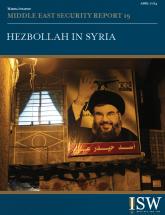 |
 |
Hezbollah in Syria

Hezbollah’s deepening involvement in Syria is one of the most important factors of the conflict in 2013 and 2014. Since the beginning of 2013, Hezbollah fighters have operated openly and in significant numbers across the border alongside their Syrian and Iraqi counterparts. They have enabled the regime to regain control of rebel-held areas in central Syria and have improved the effectiveness of pro-regime forces. The impact of Hezbollah’s involvement in Syria has been felt not just on the battlefield, where the regime now has momentum in many areas, but also in Lebanon where growing sectarian tensions have undermined security and stability.
This paper details Hezbollah’s involvement in Syria from the beginning of the conflict to the present. Much of the focus is on 2013, when Hezbollah publicly acknowledge its presence in Syria and deepened its commitment on the ground. The first part of the paper explores the relationship between Hezbollah, Iran, and Syria and Hezbollah’s rationale for its involvement in Syria. The second part looks at Hezbollah’s activities in Syria from 2011 to 2012, when it operated on a limited and clandestine basis. The third section of the paper details Hezbollah’s escalation of its presence in 2013 and examines the group’s role in operations across Syria since the beginning of 2013. The fourth part analyzes the size, scope, and structure of Hezbollah’s operations in Syria. Finally, the paper concludes with a discussion of the implications of Hezbollah’s growing presence in Syria within Lebanon, Syria, and more broadly.
Background: The Axis of Resistance
The Axis of Resistance is an Iran-led alliance of state and non-state actors in the Middle East that seeks to confront Western interests in the region, namely those of the United States and Israel. Historically, this alliance has included the Assad regime in Syria and Lebanese Hezbollah. In recent years, Iran has also cultivated Iraqi Shi’a militants as the newest members of this alliance. Aside from shared regional objectives, another pillar of the axis is shared support. Iran provides extensive material, financial, training, and logistical assistance to its regional partners. For example, Iran has supplied Hezbollah with as much as $200 million each year. After Hezbollah’s 2006 war with Israel, Iran and Syria rearmed Hezbollah with vastly expanded and more sophisticated weaponry. Much of this support has flowed through Syria, making it the primary hub in Iran’s power projection in the Levant.
The war in Syria presents a significant, even existential, threat to this strategic alliance by endangering one of its primary members and the chief conduit for Iranian support to Hezbollah. At the same time, Iran cannot afford to lose its most important foothold in the Levant, and Hezbollah cannot risk losing its access to critical Iranian and Syrian support. Maintaining the Axis of resistance is also a matter of great ideological importance for Iran and its commitment to exporting its Islamic revolutionary principles. For all of these reasons, Iran will go to great lengths to preserve its foothold in Syria.